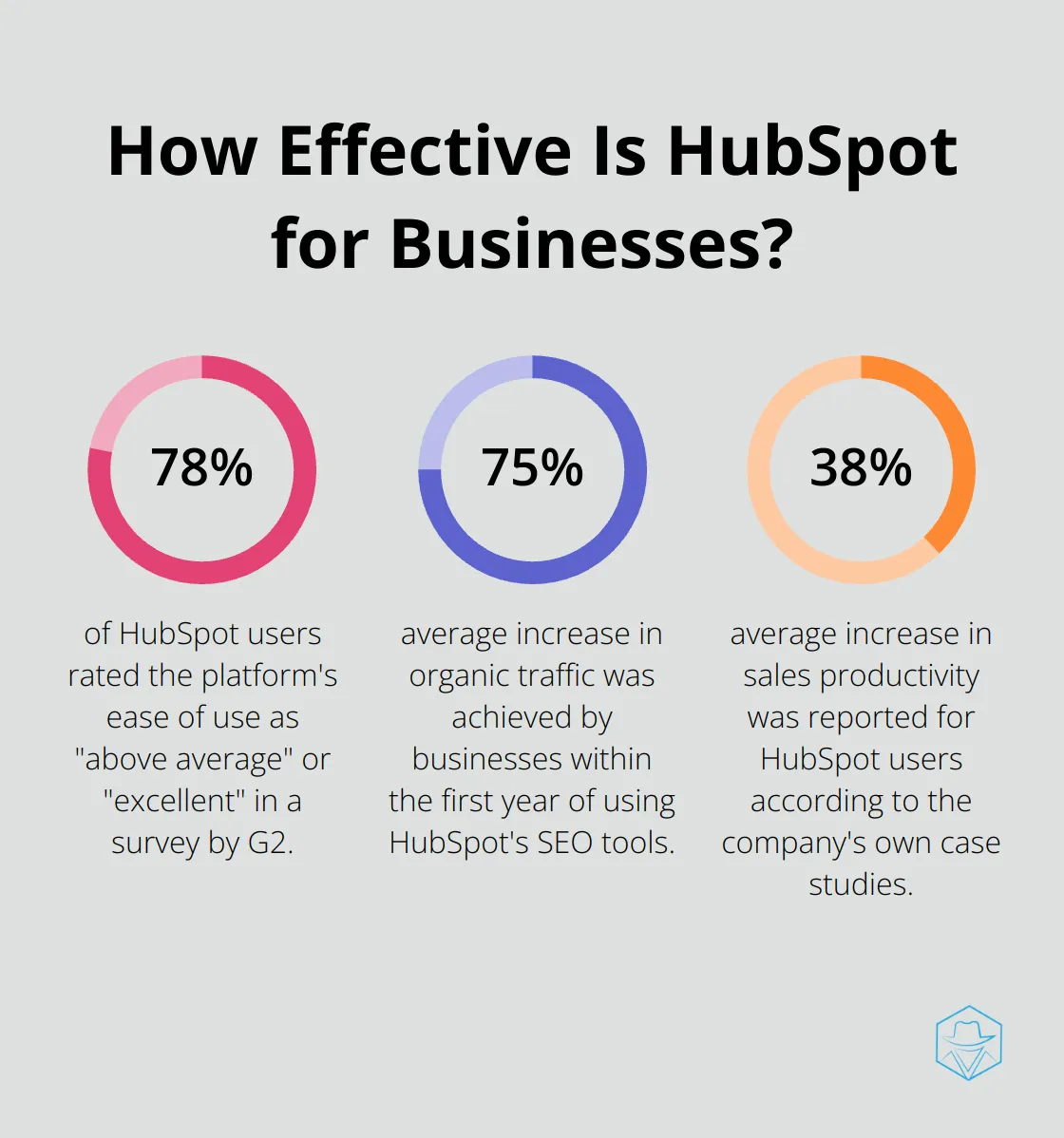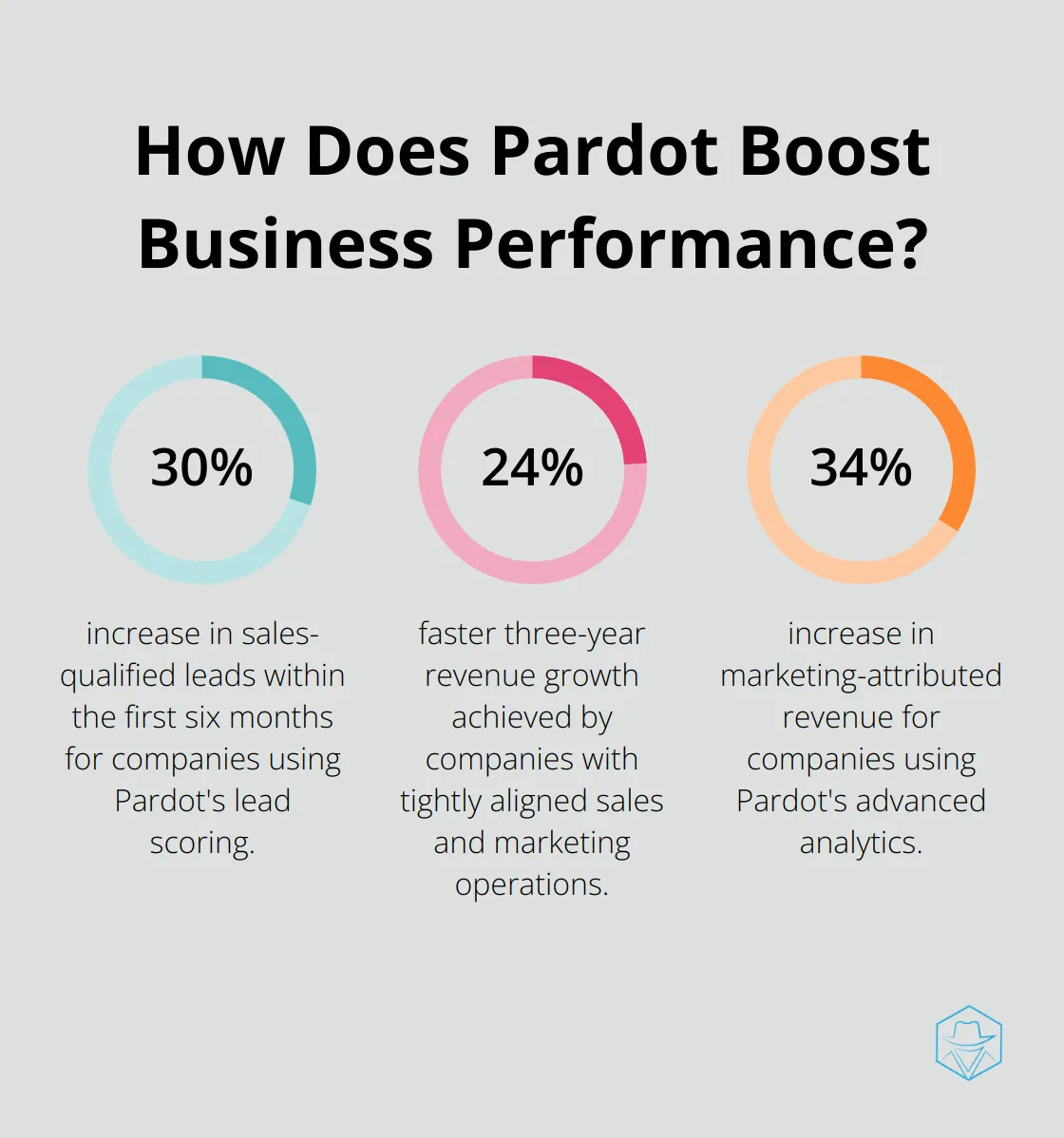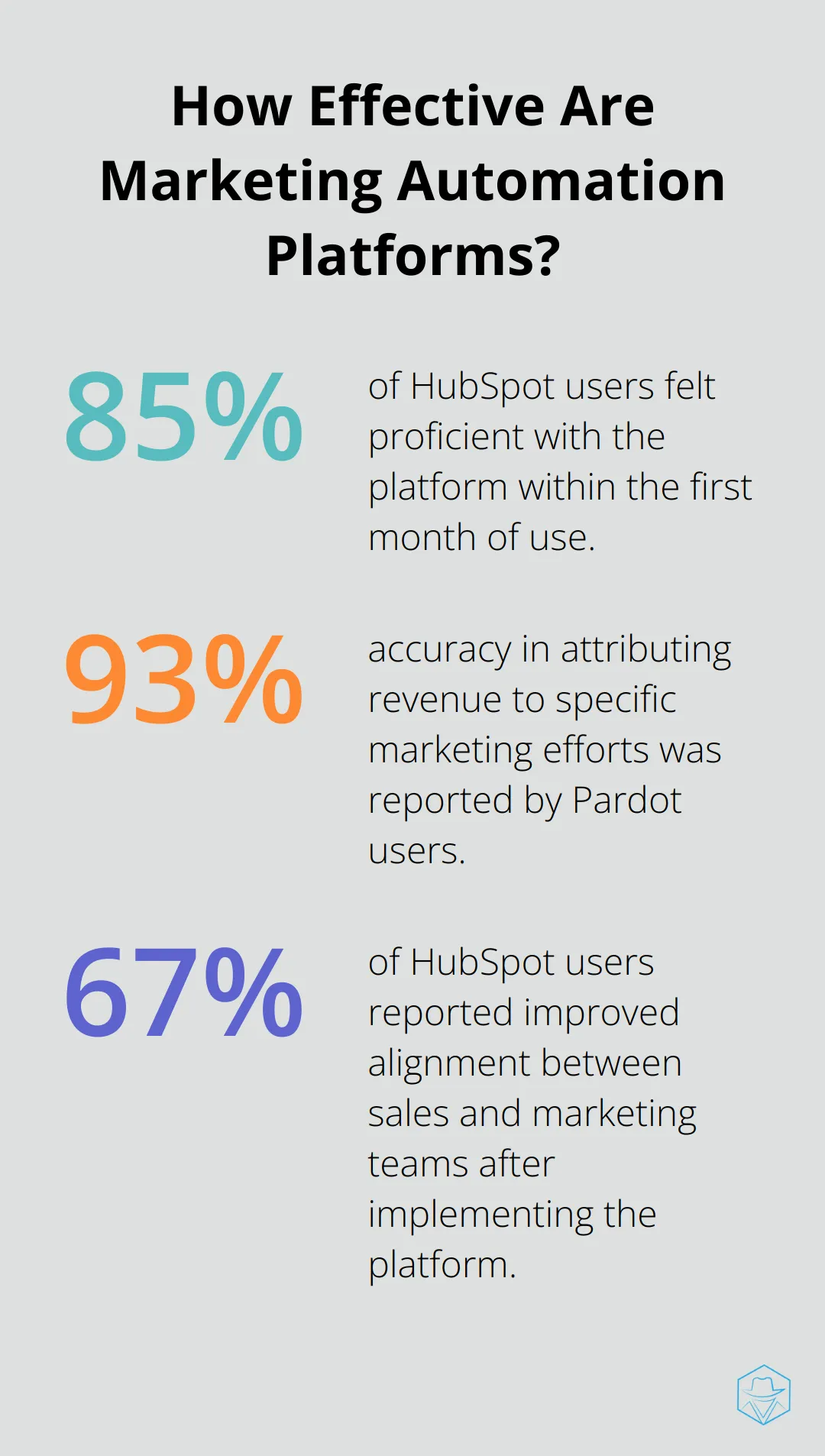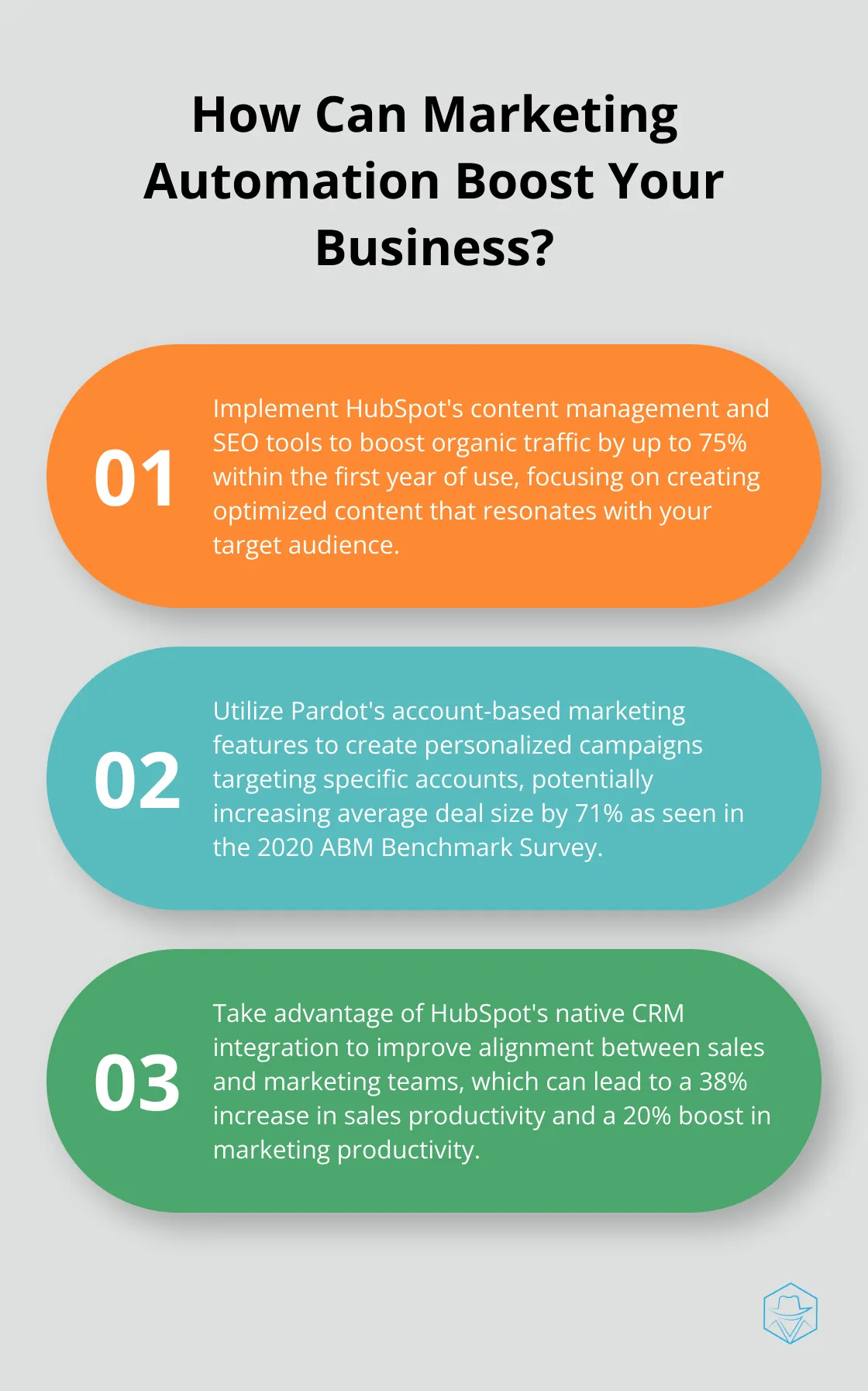HubSpot vs Pardot: Battle of Marketing Automation

At Drop Cowboy, we’re often asked about the best marketing automation tools for businesses. Two giants in this space are HubSpot and Pardot.
In this post, we’ll compare HubSpot vs Pardot, exploring their features, strengths, and how they stack up against each other. We’ll help you decide which platform might be the right fit for your marketing needs.
What Makes HubSpot Stand Out?
All-in-One Solution
HubSpot offers a comprehensive suite of tools that cater to various aspects of digital marketing, sales, and customer service. This integration saves time and reduces the learning curve for teams. A study by Forrester Research found that companies using HubSpot reported a 20% increase in marketing productivity. The platform consolidates multiple marketing tasks into a single ecosystem, eliminating the need to juggle various platforms.
User-Friendly Interface
HubSpot’s interface prioritizes user experience. Even those new to marketing automation find it intuitive and easy to navigate. This accessibility proves crucial for small to medium-sized businesses that may lack dedicated technical staff. A survey by G2 revealed that 78% of HubSpot users rated the platform’s ease of use as “above average” or “excellent.”
Content Management and SEO
Content creation and management are areas where HubSpot excels. The platform provides robust blogging tools, SEO recommendations, and content strategy features. These tools help businesses create and optimize content that resonates with their target audience. HubSpot’s SEO tools have increased organic traffic by an average of 75% for businesses within the first year of use.
CRM Integration
HubSpot’s native CRM integration transforms many businesses’ operations. It allows for seamless data flow between marketing and sales teams, ensuring proper lead nurturing and follow-up. This integration has led to an average 38% increase in sales productivity for HubSpot users (according to the company’s own case studies).
Pricing and Scalability
HubSpot offers a free tier with basic features, but its paid plans can be expensive for small businesses. However, the platform scales well with business growth, offering increasingly sophisticated features at higher tiers. While the initial investment may be high, many businesses report a significant ROI. A study by MIT Sloan found that companies using HubSpot saw an average 181% increase in marketing-generated revenue within two years.

As we move on to examine Pardot’s features and strengths, it’s important to note that while HubSpot offers a robust all-in-one solution, businesses with specific B2B needs might find Pardot’s specialized features more appealing. Let’s explore what sets Pardot apart in the next section.
Pardot’s B2B Marketing Powerhouse
B2B Focus and Lead Management
Pardot, now part of Salesforce, has established itself as a formidable B2B marketing automation platform. Its sophisticated lead scoring and grading system allows marketers to prioritize leads based on both demographic fit and engagement level. This dual approach helps sales teams focus on the most promising prospects, potentially reducing sales cycles.

A study by Demand Gen Report revealed that companies using Pardot’s lead scoring experienced a 30% increase in sales-qualified leads within the first six months. This improvement in lead quality can significantly impact a B2B company’s revenue (especially for those with complex sales processes).
Seamless Salesforce Integration
Pardot’s integration with Salesforce CRM is its standout feature. This tight coupling enables real-time synchronization of lead data, ensuring that sales and marketing teams always have access to the most up-to-date information. A survey by SiriusDecisions found that companies with tightly aligned sales and marketing operations achieved 24% faster three-year revenue growth.
For businesses already using Salesforce, Pardot’s integration can streamline operations and improve data consistency across departments.
Robust Analytics and Reporting
Pardot offers powerful analytics capabilities, providing deep insights into campaign performance and ROI. The platform’s B2B Marketing Analytics tool features customizable dashboards and AI-powered insights, enabling marketers to make data-driven decisions.
A case study by Salesforce showed that companies using Pardot’s advanced analytics saw an average 34% increase in marketing-attributed revenue. This level of insight proves invaluable for B2B marketers who need to justify and optimize their marketing spend.
Account-Based Marketing Features
Pardot’s account-based marketing (ABM) features stand out in the B2B world. The platform enables marketers to create personalized campaigns targeting specific accounts, a strategy that’s gaining significant traction. According to the 2020 ABM Benchmark Survey by ITSMA, companies implementing ABM strategies saw a 71% increase in average deal size.
While Pardot offers powerful features for B2B marketers, businesses looking for a more versatile platform that caters to both B2B and B2C needs might find Drop Cowboy’s flexible solution, with its advanced communication features and AI-powered personalization, a better fit. In the next section, we’ll compare HubSpot and Pardot head-to-head across various key features to help you make an informed decision.
HubSpot vs Pardot: Performance Comparison
Ease of Use and Learning Curve
HubSpot leads in user-friendliness. Its intuitive interface and comprehensive onboarding process make it accessible for marketing novices. A G2 survey revealed that 85% of HubSpot users felt proficient with the platform within the first month of use.

Pardot, while powerful, presents a steeper learning curve. Its B2B focus and advanced features can overwhelm newcomers. A Salesforce study found that Pardot users typically need 2-3 months to master the platform’s full capabilities.
Lead Management and Email Marketing
Both platforms excel in lead management, but their approaches differ. HubSpot’s lead scoring offers more flexibility, allowing easy customization based on various actions and attributes. This flexibility has resulted in a 20% increase in lead conversion rates for HubSpot users (according to a HubSpot case study).
Pardot’s lead scoring proves more sophisticated, particularly for B2B scenarios. Its Engagement Studio enables complex, branching automation workflows. A Salesforce report indicated that Pardot users experienced a 34% increase in sales-ready leads after implementing these advanced scoring mechanisms.
In email marketing, HubSpot’s drag-and-drop editor and AI-powered subject line suggestions simplify the creation of engaging emails. The platform’s users report an average open rate increase of 12% when using these tools.
Pardot’s email capabilities focus on personalization and segmentation. Its dynamic content features have helped users achieve click-through rates up to 14% higher than industry averages (as per a Pardot benchmark report).
Analytics and Integration
Pardot excels in analytics, especially for B2B marketers. Its B2B Marketing Analytics dashboards provide deep insights into the entire customer journey. Users report the ability to attribute revenue to specific marketing efforts with 93% accuracy.
HubSpot’s analytics offer more accessibility but less granularity. However, its native CRM integration provides a holistic view of the customer lifecycle. A HubSpot study found that 67% of its users reported improved alignment between sales and marketing teams after implementing the platform.
For integrations, HubSpot boasts over 500 native options, making it highly versatile. Pardot, while having fewer integrations, offers deeper connectivity with Salesforce products, which proves essential for many B2B companies.
Pricing and Value
HubSpot’s pricing model offers more flexibility, with a free tier and various paid plans. This structure makes it accessible for small businesses, though costs can escalate quickly as features are added. The average HubSpot user spends $800-$3,200 per month (depending on their plan and add-ons).
Pardot’s pricing starts higher, with plans ranging from $1,250 to $4,000 per month. While this may seem steep, many B2B companies find the ROI justifies the cost. A Salesforce study reported that Pardot users saw an average 34% increase in marketing-attributed revenue within the first year.
For businesses seeking a more cost-effective solution with advanced features (like AI-powered voice cloning and global SMS capabilities), Drop Cowboy offers a compelling alternative. Its pay-per-successful-delivery model ensures charges only for messages that reach the audience, potentially offering better value for money compared to the flat-rate structures of HubSpot and Pardot.
Final Thoughts
HubSpot and Pardot offer powerful marketing automation capabilities with distinct strengths. HubSpot excels as an all-in-one solution for small to medium-sized businesses, while Pardot shines as a B2B marketing powerhouse for larger enterprises. Your choice between HubSpot vs Pardot depends on your business size, industry, and specific marketing needs.

Both platforms come with significant costs, especially when scaling up features and users. For businesses seeking a more cost-effective alternative with advanced features, Drop Cowboy provides a unique blend of affordability and cutting-edge technology. Its pay-per-successful-delivery model and innovative features like AI-powered voice cloning and global SMS capabilities make it a compelling option.
The decision between HubSpot, Pardot, or alternatives like Drop Cowboy will impact your marketing success for years to come. Consider your specific business goals, budget, and required level of marketing automation sophistication when making your choice. Evaluate each platform’s strengths against your needs to make an informed decision that will drive your marketing efforts forward.
blog-dropcowboy-com
Related posts

April 21, 2025
Boost Sales & Engagement | SMS & Ringless Voicemail Marketing App for Shopify
Boost sales & engagement with our top SMS & ringless voicemail marketing tool, available on Shopify App Store. Maximize customer outreach effortlessly.

April 21, 2025
How to Maximize ROI with Klaviyo Email Marketing
Boost ROI with Klaviyo email marketing by optimizing strategies, increasing engagement, and leveraging data-driven insights for better campaign performance.

March 11, 2025
Effective Text Marketing Templates for Your Business
Boost engagement with effective text marketing templates. Enhance reach, connect with customers, and elevate your business communication strategy.

March 11, 2025
Combining Ringless Voicemail and SMS for Better Results
Boost engagement by combining ringless voicemail and SMS. Explore benefits, strategies, and real-world examples for improved communication.

March 12, 2025
How to Create an Effective Marketing Automation Journey
Boost your business by creating an effective marketing automation journey. Streamline processes, engage customers, and drive growth effortlessly.

April 14, 2025
What is Triple Whale and How Can It Boost Your Business?
Learn what Triple Whale is and how it boosts business growth with data analytics and insights, driving sales and increasing efficiency.